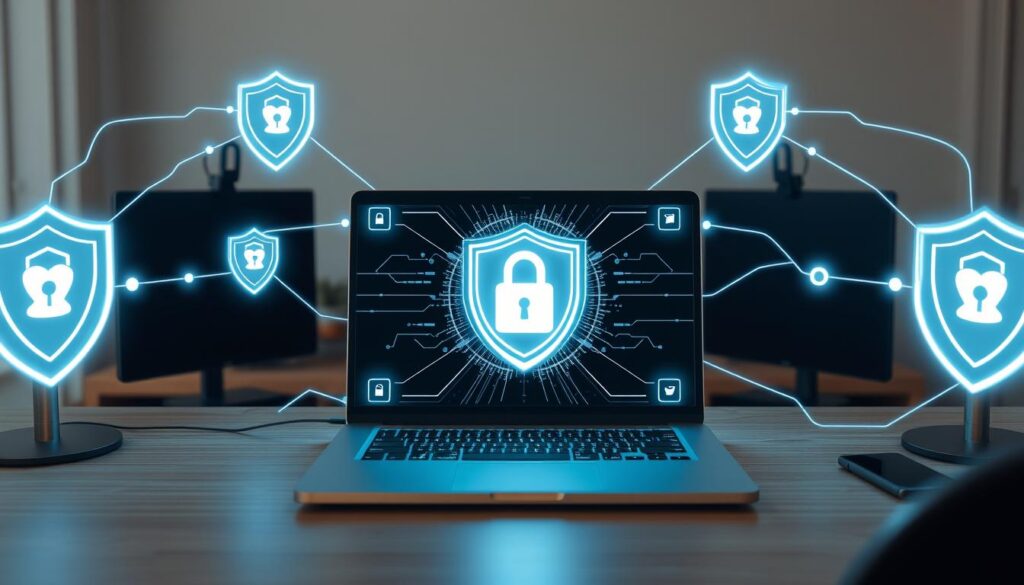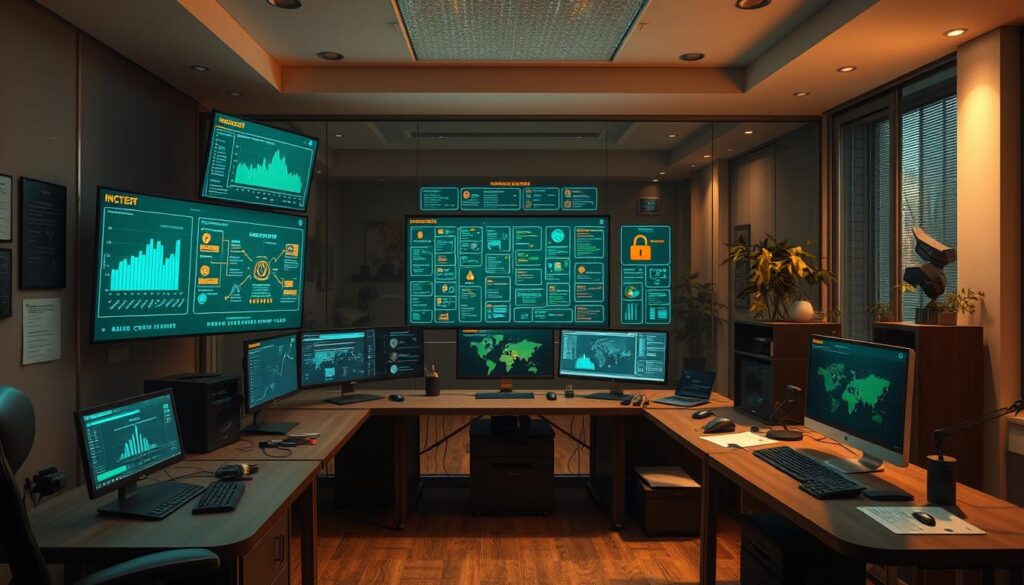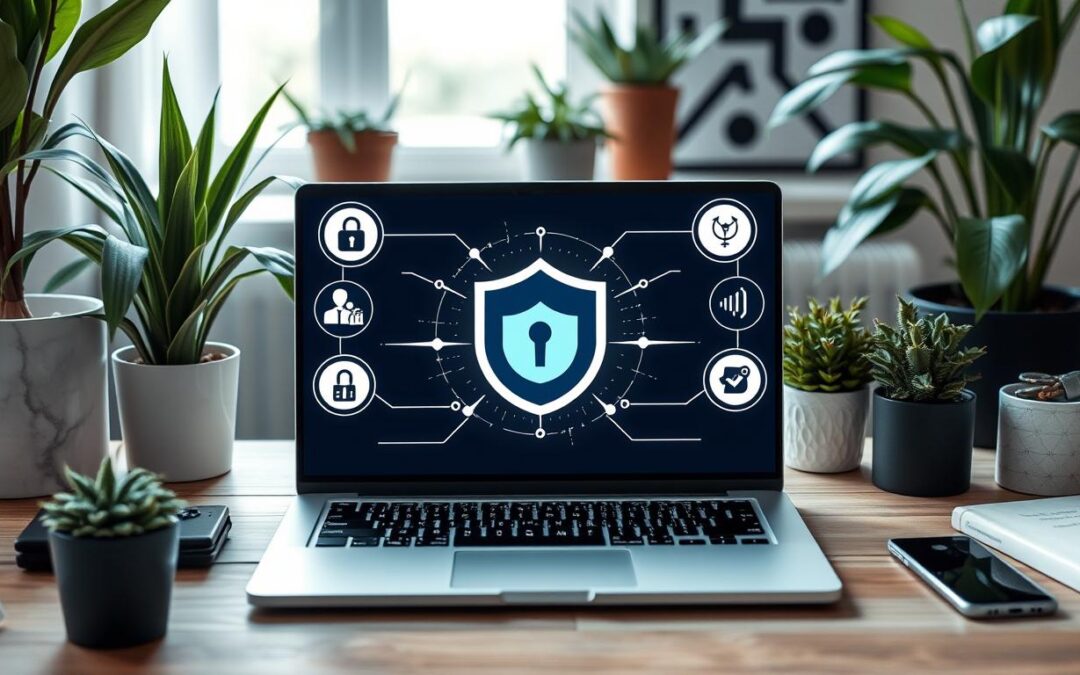Remote work has become the new norm in our fast-changing digital world. It’s more important than ever to focus on cybersecurity. Working from home means we must protect our sensitive data and stay productive. This article will share key strategies and best practices to keep your remote team safe and secure.
Key Takeaways
- Understand the growing cyber threats facing remote workers and how to mitigate them.
- Leverage virtual private networks (VPNs) to secure remote access to your network and data.
- Implement robust cloud security measures to safeguard information stored and shared in the cloud.
- Enhance login security with multi-factor authentication to prevent unauthorized access.
- Ensure comprehensive endpoint protection for all devices used by your remote team.
The Importance of Cybersecurity for Remote Workers
Remote work is becoming more common, making cyber threat awareness more important than ever. Protecting data privacy and keeping sensitive information safe is a big concern for everyone.
Cyber Threats on the Rise
Remote work has brought new risks for cyber attacks. Hackers are targeting remote workers with scams and malware. It’s key to teach employees about cyber threat awareness to fight these threats.
Protecting Sensitive Data and Maintaining Productivity
Remote workers often deal with sensitive data. Keeping this data safe is vital for data privacy and following rules. Cyber attacks can also hurt productivity, so having a good incident response plan is crucial.
Strong cybersecurity measures and a culture of cyber threat awareness help remote workers stay safe and productive. This is especially important as cyber threats keep changing.
“Cybersecurity is no longer just an IT issue – it’s a critical business imperative that affects every aspect of an organization’s operations.”
With remote work becoming the standard, byod policies and data privacy must be top priorities. By focusing on cybersecurity, businesses can keep their remote teams successful and safe.
Cybersecurity for Remote Work
In today’s world of remote work, keeping your remote workforce safe from cyber threats is key. Hackers are now targeting home networks and personal devices. So, it’s vital for companies to have strong security plans in place.
To keep your remote workforce safe, here are some top cybersecurity tips:
- Use Virtual Private Networks (VPNs) to keep company data safe when accessed remotely.
- Choose cloud-based security solutions to protect data stored and accessed online.
- Make sure to use multi-factor authentication to add extra security to logins.
- Install endpoint protection like antivirus and firewalls on remote devices.
- Teach your remote team about security awareness to help them spot and stop cyber threats.
By following these cybersecurity tips, you can protect your remote workforce. This ensures your data and systems stay safe and secure.
| Cybersecurity Measure | Benefits |
|---|---|
| Virtual Private Networks (VPNs) | Secure remote access, encrypt network traffic, and protect against unauthorized access. |
| Cloud Security | Safeguard data stored and accessed in cloud-based platforms, ensure compliance, and maintain data integrity. |
| Multi-Factor Authentication | Enhance login security by requiring additional verification factors, reducing the risk of unauthorized access. |
By using these cybersecurity steps, you can keep your remote workforce safe. This ensures your remote work stays secure and productive.
Virtual Private Networks (VPNs): Secure Remote Access
Remote work is more common than ever. This makes secure remote access solutions crucial. Virtual private networks (VPNs) are a key tool. They protect your organization’s data and ensure productivity, even when your team is far apart.
Understanding VPNs and Their Benefits
VPNs create an encrypted tunnel between your device and the internet. This provides a secure connection that hides your online activities. By using a remote server, VPNs hide your IP address and protect your data from cyber threats.
The main benefits of VPNs for remote work are:
- Enhanced data security and privacy
- Secure access to company resources and internal networks
- Bypassing geographic restrictions and censorship
- Improved online anonymity and freedom
Choosing the Right VPN Solution
Choosing the right VPN can be tough with so many options. When picking a VPN, consider these factors:
- Server locations: Make sure the VPN has servers in many places for better performance and access.
- Security features: Look for strong encryption, like AES-256, and features like a kill switch to protect your data.
- Logging policies: Pick a VPN that doesn’t log your activities to keep your online life private.
- Ease of use: Choose a VPN that’s easy to use and fits well with your remote work setup.
- Reliability and speed: Test the VPN to make sure it’s fast and reliable for productive remote work.
Using virtual private networks can greatly improve your organization’s cybersecurity. It lets your remote team work securely and efficiently, no matter where they are.
Cloud Security: Protecting Data in the Cloud
In today’s world, cloud security is key. More companies use cloud storage and collaboration tools. It’s important to know how to keep data safe in the cloud.
Cloud security protects sensitive data. It makes sure data stays private, safe, and accessible.
Cloud Storage and Collaboration Platforms
Cloud storage like Google Drive, Dropbox, and Microsoft OneDrive lets remote workers access files easily. But, it’s vital to have strong cloud security to protect your company’s data.
Secure collaboration tools like Microsoft Teams, Slack, and Google Workspace help teams work together online. But, they need strong cloud security to keep shared information safe.
“The cloud is the new frontier for cybersecurity, and companies must be proactive in protecting their data and ensuring the security of their remote workforce.”
To keep your remote work safe, use encryption, access controls, and backups. This way, your remote team can work safely and efficiently. Your company’s sensitive information stays protected.
Multi-Factor Authentication: Enhancing Login Security
In today’s world, remote work is more common than ever. This makes login security more important than ever. A key tool in keeping things safe is multi-factor authentication (or multi-factor authentication).
Multi-factor authentication adds an extra step to log in. It’s not just a username and password. It might ask for a code sent to your phone or a scan of your face. This makes your login much safer.
Here are some key benefits of using multi-factor authentication for remote work:
- It makes it harder for hackers to get into your systems and data, even if they have your password.
- It helps your company follow rules and standards that require extra security for sensitive info.
- It’s designed to be easy to use, so it doesn’t slow you down too much.
When picking a multi-factor authentication system, look at how easy it is to use. Also, check if it works well with your current systems. Using multi-factor authentication means your remote workers’ logins are extra safe.
“Implementing multi-factor authentication is one of the most effective ways to safeguard remote work environments against unauthorized access and data breaches.”
Endpoint Protection: Securing Devices and Networks
In the world of remote work, keeping your devices and networks safe is key. Endpoint protection is at the heart of a strong cybersecurity plan. It protects your remote team from many dangers. Tools like antivirus and firewall software and keeping software and systems up-to-date are vital.
Antivirus and Firewall Software
Starting with antivirus and firewall software is essential. These tools fight off malware, viruses, and unauthorized access. They keep your devices and networks safe from harm.
Keeping Software and Systems Up-to-Date
Keeping your software and systems current is also key. Security updates from developers help protect against new threats. By updating regularly, you lower the risk of attacks.
Using a strong endpoint protection plan is vital for remote work security. It combines antivirus, firewall, and updates to protect your team and data.

“Cybersecurity is not just an IT issue, it’s a business imperative. Protecting your remote workforce is crucial for maintaining productivity, safeguarding sensitive data, and ensuring business continuity.”
Data Encryption: Safeguarding Sensitive Information
In today’s world of remote work, keeping data safe is key. Data encryption is crucial for keeping your team’s info secure. It helps protect your company’s important data and keeps your clients and partners trusting you.
Encrypting Data at Rest and in Transit
Data encryption covers two main areas: data at rest and data in transit. Encrypting data at rest, like files on devices or in the cloud, stops unauthorized access. It also protects data if there’s a breach. Encrypting data in transit, like during file transfers, keeps your team’s chats safe from others.
To keep your data safe, consider these steps:
- Use strong encryption like AES to protect data at rest and in transit.
- Choose secure file-sharing tools that encrypt everything your team shares.
- Make sure all important messages, like emails and chats, are encrypted to keep them private.
By using data encryption, you keep your team’s data safe. This also helps you follow industry rules and builds a strong cybersecurity culture in your company.
Data encryption is more than just a tech fix. It’s a key part of your cybersecurity plan for remote work. By focusing on keeping data safe, you let your team work securely and confidently, even with new cyber threats.
Security Awareness Training: Educating Remote Employees
In today’s world of remote work, security awareness training is key to keeping organizations safe from cyber threats. With employees working from home, they’re more at risk of falling for phishing attempts and social engineering tricks. It’s vital to teach remote workers about cybersecurity best practices to keep data safe and work efficiently.
Identifying Phishing Attempts and Social Engineering Tactics
Phishing scams, where hackers try to get employees to share sensitive info or do harmful actions, are getting more common. Remote workers need to know how to spot and dodge these tricks. Security awareness training can teach them to:
- Spot suspicious emails and websites
- Check if requests for personal or financial info are real
- Spot social engineering tricks like fake impersonations
- Tell the IT security team about any odd activities
By teaching remote employees how to spot phishing, companies can lower the chance of data breaches and cyber attacks.
Good security awareness training does more than just protect the company. It also builds a culture of cybersecurity awareness among remote workers. When employees know how to handle threats, they become the first defense against cyber attacks.
Incident Response Planning: Preparing for the Worst
In the fast-paced world of remote work, cybersecurity threats can pop up anytime. It’s vital to have a solid incident response plan. This plan helps your team quickly handle and recover from security issues like data breaches and malware.
Developing an Incident Response Plan
Creating a good incident response plan takes a few important steps:
- Identify and prioritize potential security risks: Look closely at your remote work setup to find the biggest threats and weaknesses.
- Establish clear roles and responsibilities: Choose a team for incident response and define each role.
- Implement communication protocols: Set up ways to communicate well during an incident. This includes talking to your team, stakeholders, and outside groups like law enforcement.
- Outline incident response procedures: Write down the steps for each part of the response process, from finding the problem to fixing it and getting back to normal.
- Regularly test and update the plan: Do practice runs to check if the plan works. Update it as needed to stay ahead of new threats and best practices.
By planning ahead and having a solid incident response plan, your team can handle security issues better. This helps reduce downtime, financial losses, and damage to your reputation.

“Proper incident response planning is the key to effective crisis management and business continuity in the face of a security breach.”
| Key Elements of an Incident Response Plan | Description |
|---|---|
| Incident Identification and Classification | Set clear rules for spotting and sorting security incidents by how bad they are and their impact. |
| Incident Containment and Eradication | Describe how to stop the incident, prevent more harm, and find and fix the main problem. |
| Incident Recovery and Restoration | Explain how to get back to normal, recover lost data, and cut downtime. |
| Post-Incident Review and Lessons Learned | Do a deep analysis to find ways to improve and update the plan as needed. |
Secure Collaboration Tools: Enabling Safe Remote Work
Remote work is now the norm, and keeping data safe is key. With teams spread out, protecting sensitive information is crucial. Luckily, many secure collaboration tools are available to support your team’s digital work.
Look for tools with end-to-end encryption. This keeps your chats and files private, even if hackers try to get in. Cloud platforms like Microsoft Teams and Google Workspace have strong encryption. They let your team work together safely.
Also, choose tools with strict access controls. This way, you can limit who sees what, lowering the risk of data leaks. Dropbox Business and Box offer these features to protect your digital stuff.
Tools with built-in security, like threat monitoring and updates, are also good. Slack and Zoom are great for keeping your team safe while they work together.
| Collaboration Tool | Key Security Features |
|---|---|
| Microsoft Teams | End-to-end encryption, multi-factor authentication, data loss prevention |
| Google Workspace | Encrypted communication, user access controls, advanced security analytics |
| Dropbox Business | Granular access management, two-factor authentication, remote device wipe |
| Box | Enterprise-grade encryption, user activity logging, real-time threat detection |
| Slack | Automated security updates, single sign-on, data loss prevention |
| Zoom | Waiting rooms, end-to-end encryption, password-protected meetings |
Using secure collaboration tools lets your team work together safely. They can share info and collaborate without risking data. With the right tools, your team can work securely from anywhere.
Bring Your Own Device (BYOD) Policies: Securing Personal Devices
In today’s world, Bring Your Own Device (BYOD) policies are key. They help companies manage personal devices used by employees. This ensures data safety and keeps work flowing smoothly.
Establishing BYOD Guidelines and Best Practices
Creating strong byod policies is a big job. Companies need to follow these steps:
- Set clear rules for device use, including security and what’s allowed.
- Use strong ways to check who’s accessing company stuff, like multi-factor authentication.
- Make sure data on personal devices is encrypted to keep it safe.
- Teach employees about BYOD security and how to use devices wisely.
- Keep byod policies up to date to fight new threats and tech changes.
By making good byod policies and following best practices, companies can support their remote teams. This way, they can work well and stay safe, which is vital today.
“Effective byod policies are the backbone of a secure remote work environment, protecting both the organization and its employees.”
Conclusion
Cybersecurity is key for remote work, with more cyber threats around. Using VPNs, cloud security, multi-factor authentication, and endpoint protection helps keep data safe. This protects the remote workforce and their sensitive information.
Teaching employees about security is vital. They need to know how to spot phishing and social engineering. Having a plan for incidents and using secure tools also helps. Plus, clear BYOD policies keep personal devices safe in the corporate network.
With these steps, remote teams can work safely and efficiently. This reduces risks from new threats. As remote work grows, keeping cybersecurity strong is crucial for everyone’s safety and success.
FAQ
What is the importance of cybersecurity for remote workers?
Cybersecurity is now more important than ever with the rise of remote work. Remote workers face many cyber threats. It’s key to keep their data safe and work productively from home.
How can virtual private networks (VPNs) provide secure remote access?
VPNs make a safe, encrypted link between remote devices and your network. This protects important info and lets your team access your network safely.
How can cloud security be ensured for remote workers?
It’s vital to secure cloud storage and collaboration tools used by remote workers. This protects cloud data and makes remote work safe.
What is the importance of multi-factor authentication for remote workers?
Multi-factor authentication boosts security for remote workers’ login details. It stops unauthorized access to important systems and data.
How can endpoint protection secure devices and networks used by remote workers?
Using antivirus and firewall software, and keeping software updated, is key. It secures devices and networks for your remote team.
Why is data encryption important for remote work?
Encrypting data keeps your remote team’s communications and info safe. It ensures data stays confidential and intact.
What is the importance of security awareness training for remote employees?
Training helps remote workers spot phishing and social engineering. It stops data breaches and cyber attacks.
How can an incident response plan help in a remote work environment?
A good incident response plan helps your team quickly handle and recover from cyber attacks. It’s crucial in a remote work setting.
What should be considered when selecting secure collaboration tools for remote work?
Choose collaboration tools that protect data privacy and security. This lets your team work together safely and efficiently.
How can BYOD (Bring Your Own Device) policies help secure personal devices used for remote work?
Good BYOD policies secure personal devices for remote work. They ensure your organization’s data stays safe.

